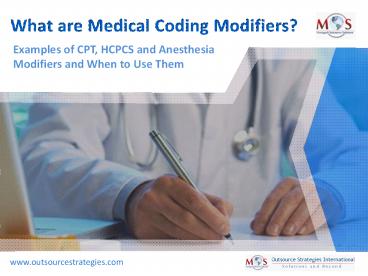What are Medical Coding Modifiers? Examples of CPT, HCPCS and Anesthesia Modifiers and When to Use Them - PowerPoint PPT Presentation
Title:
What are Medical Coding Modifiers? Examples of CPT, HCPCS and Anesthesia Modifiers and When to Use Them
Description:
Knowing CPT, HCPCS and anesthesia modifiers and when to use them is critical for physicians receive proper reimbursement for services provided. – PowerPoint PPT presentation
Number of Views:253
Title: What are Medical Coding Modifiers? Examples of CPT, HCPCS and Anesthesia Modifiers and When to Use Them
1
What are Medical Coding Modifiers?
Examples of CPT, HCPCS and Anesthesia Modifiers
and When to Use Them
www.outsourcestrategies.com
2
Using CPT, HCPCS and anesthesia modifiers
correctly is critical to communicate details
regarding the performance of a medical procedure
or service to payers. Modifiers are two-character
codes that provide more meaning to the procedure
codes original definition. By using modifiers
correctly and communicating specific information
to the insurance carriers, medical billing and
coding companies ensure that physicians get paid
appropriately for services rendered
Features of Modifier Codes
- Modifier codes can be two digit numbers, two
character - modifiers, or alpha-numeric indicators
- They are a tool to provide more detail to the
performance of - a medical procedure or service
- They are always placed at the end of a CPT
code, separated - with a hyphen
- Up to 4 modifiers may be stated on a claim
- Functional modifiers affect reimbursement and
informational - modifiers provide information about the
procedure - HCPCS Level II modifiers are used to provide
additional - information about services provided to
patients covered by - a payer that accepts HCPCS Level II codes.
www.outsourcestrategies.com
3
Code Modifiers Clarify the Following
- Whether a service or procedure has a
professional component or a technical - component
- If multiple procedures were performed or only
part of a service was performed - Why a procedure was necessary
- The location on the body where the procedure
was performed - Whether the service or procedure was performed
by more than - one physician
- Whether a service or procedure was provided
more than once - Unusual events occurred
- An add-on or additional service was performed
- Other information that may be vital to a
claims - specific reimbursement status
www.outsourcestrategies.com
4
Commonly Used CPT and HCPCS Modifiers
CPT Modifiers
22 Unusual procedural services 23 Unusual
anesthesia 24 Unrelated evaluation and
management service by the same physician
during a postoperative period 25 Significant,
separately identifiable EM service by the same
physician on the same day
of the procedure or service 26 Professional
component 27 Multiple outpatient hospital EM
encounters on the same date 32 Mandated
services 47 Anesthesia by surgeons 50 Bilateral
procedure 51 Multiple procedures Indicates that
multiple procedures (other
than E/M services) 52 Reduced services 53
Discontinued procedure 54 Surgical care only
www.outsourcestrategies.com
5
57 Decision for Surgery - Indicates an E/M
service that resulted in the initial
decision to perform a surgery 58 Staged or
related procedure or service by the same
physician during the postoperative
period 59 Distinct Procedural Service - Indicates
that a non-E/M procedure or service was
distinct or independent from other non-E/M
services performed on the same
day XE-Separate Encounter XP-Separate
Practitioner XS-Separate Organ/Structure XU-
Unusual Non-overlapping Service 76 Repeat
procedure or service by same physician or other
qualified healthcare professional 77 Repeat
procedure by another physician or other
qualified healthcare professional 95
Synchronous telemedicine service rendered via
real-time interactive audio and video
telecommunications system
www.outsourcestrategies.com
6
HCPCS Modifiers
- Anatomical Modifiers Anatomical modifiers
indicate the area or part of the body on which
the procedure is performed on different sites
during the same session. Examples - E1E4 Eyelids
- FAF9 Fingers
- TAT9 Toes
- RT Right
- LT Left
- LC Left circumflex, coronary artery
- LD Left anterior descending coronary artery
- LM Left main coronary artery
- RI Ramus intermedius
- RC Right coronary artery
www.outsourcestrategies.com
7
Modifiers for Anesthesia Claims
Correct use of anesthesia modifiers is necessary
for proper claims payment.
AA Anesthesia services performed personally by
anesthesiologist informs the payer that
the anesthesiologist provided care to the
patient alone, and not alongside a certified
registered nurse anesthetist (CRNA). AD
Medical supervision by a physician more than
four concurrent anesthesia procedures QZ
CRNA service without medical direction by a
physician QY Medical direction of one certified
registered nurse anesthetist by an
anesthesiologist QK Medical direction of two,
three or four concurrent anesthesia
procedures involving qualified individuals QX
CRNA service with medical direction by a
physician QS Monitored anesthesia care (MAC)
provided by an anesthesiologist P1P6
Anesthesia Physical Status Modifiers
www.outsourcestrategies.com
8
Use of Modifiers - Key Points to Note
- There are strict rules and regulations to using
modifiers that must be followed - at all times
- When two or more modifiers are used, the
functional modifier should be listed - first, followed by all the other modifiers
- The documentation within the medical record to
support the use of each - modifier should be clear
- While some modifiers can be used only with
Evaluation and Management - (EM) codes, there are several modifiers that
are not compatible with - EM codes
- Incorrect use of modifiers prevents the provider
from receiving the - full reimbursement for the services performed
and vice versa - Repeated misuse of modifiers will attract
scrutiny and trigger - audits
www.outsourcestrategies.com
9
CONTACT US
Call us (800) 670 2809 E-mail sales_at_managedouts
ource.com
Headquarters8596 E. 101st Street, Suite
HTulsa, OK 74133Main (800) 670
2809Fax (877) 835-5442
Thank You!
www.outsourcestrategies.com































